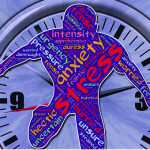Your resting heart rate is the number of times your heart beats per minute while you are at rest. You can measure it by sitting or lying down for several minutes. RHR can be used to predict both overall health and fitness level.
The normal range for resting heart rate is wide—but the lower your resting heart rate the better!
NORMAL RHR for Most Adults 60-100 Beats Per Minute
The normal RHR for most adults is 60-100 bpm, while some studies say the higher end of the normal range is 90 bpm, according to the American Heart Association.
A low resting heart rate is better because it shows that the heart doesn’t have to work as hard to pump blood. An individual’s heart rate can greatly vary based on a number of factors, so someone’s typical RHR may not fall within this generalized range—especially on the lower end for athletes.
The factors that influence your heart rate falling at the higher or lower end of this range are: age, health, fitness level, and whether you are taking medication.
Factors that Influence Heart Rate
Heart rate, even at rest, isn’t static. The heart changes in response to its environment and any stressors it experiences.
Some stressors may have a positive effect on the heart, making it stronger and more efficient, which lowers the resting heart rate. Other stressors can decrease the muscles’ efficiency. These include:
Age
The resting heart rate can increase with age, and an increased RHR is associated with an increased risk of all-cause mortality and cardiovascular disease.
Gender
Males have a lower RHR, on average, than females. Generally speaking, women have smaller hearts than men. This means they have less cardiac muscle and each heartbeat pumps less blood.
There are differences between genders when it comes to average resting heart rates, with women’s typically being higher than men’s. However, studies have shown that women typically have better cardiac function in the face of cardiac disease than men do.
The female heart is designed to compensate for the lower rate of blood circulation by increasing the heart rate. On average, adult males have a resting heart rate of 70 to 72 beats per minute, while adult females have a resting heart rate of 78 to 82 beats per minute.
Omega – 3 Fatty Acids
The intake of omega-3 fatty acids, which are found in fatty fish, has been shown to lower the resting heart rate. According to current guidelines, eating two servings of fatty fish a week is recommended to protect against cardiovascular disease.
Sodium
If you eat a lot of salt, it can make your heart rate go up. If the body has too much sodium, it will try to flush it out by increasing fluid reabsorption in the kidneys.
Cholesterol
This results in an increase in the amount of blood in the body, which causes the heart to beat faster. A diet high in saturated fat can increase heart rates because it causes high cholesterol levels and cardiac activity.
Sleep
Sleep patterns play a role in resting heart rate. A regular sleep routine that allows for enough high quality sleep can help to lower resting heart rate. A study found that delaying bedtime by 30 minutes can elevate your resting heart rate during sleep.
Dehydration
If you are dehydrated, your heart rate will increase as your body tries to distribute blood more efficiently.
Hydrate and reenergize with Purium’s Coco Hydrate a blend of coconut water, mineral salts and rooibos. The concentration of balanced electrolytes can help promote hydration after a workout, elevation shift or just an afternoon thirst quencher. One study published in the Journal of Physiological Anthropology and Applied Human Science found that participants who ingested Coconut Water after workouts recovered quicker than those who didn’t.
Alcohol
Drinking alcohol has been associated with an increased heart rate. A study conducted with 3,000 attendees of the Munich Oktoberfest showed that as the amount of alcohol people drink increases, so does their heart rate.
Fitness
Physical activity: Your heart rate can give you insight into how fit you are and how well you perform athletically. As fitness level increases, RHR (resting heart rate) has been shown to decrease—with some athletes clocking an RHR as low as 30.
Data indicates that those who work out on a regular basis have a lower resting heart rate over time, and less of a chance of dying from a high resting heart rate.
Weather
As temperatures and humidity increase, the heart has to pump more blood, which results in an increased heart rate.
Weight
Obesity can lead to an increased heart rate because the extra fat in the body requires the heart to pump more blood. This means the heart rate increases to pump blood more quickly to every part of the body.
Medication
Some medications can have an effect on the speed of your heart rate. Generally, beta blockers will slow the heart rate at which your heart beats. If you take too much thyroid medication, it could cause your heart rate to increase.
Disease
Diseases of the heart and lungs can cause an increased resting heart rate. An overactive thyroid disorder, such as Graves’ disease or toxic goiter, is a common cause of an elevated heart rate.
Posture
If you’re sitting or standing, your heart rate will likely stay the same. Standing up from a lying or sitting position can cause your heart rate to increase for 15-20 seconds, as your heart has to pump more blood to your muscles.
Environment
If you are feeling stressed, anxious, depressed, frustrated, or fearful, your heart rate will increase.
This is because emotions like these release stress hormones like cortisol and adrenaline, which tell the heart to beat faster. Your heart rate will be lower if you feel relaxed, calm, and safe.
Family History
If you have a family member with one of these conditions, you may be more likely to develop it. Some heart conditions can be passed down through families, so if you have a relative with one of these conditions, you’re more likely to get it too. If you or your family have a history of heart or blood pressure problems, you may be more likely to have a higher resting heart rate and be at greater risk for developing cardiovascular disease.
Maximum and Target Heart Rate
Your maximum heart rate is the highest number of beats per minute that your heart can safely handle. Knowing this number can help you better gauge how hard you should push yourself during physical activity. The formula for calculating your maximum heart rate is 220 – your age.
The AHA says that your target heart rate for moderately intense activities should be 50% to 70% of your maximum heart rate. You should aim for a heart rate that is 70% to 85% of your maximum heart rate during vigorous exercise.
You may experience sore joints, sore muscles, or musculoskeletal injuries if you exceed your maximum heart rate. Heart rate monitors can improve your workout by providing real-time feedback on your heart rate. This information can help you keep your heart rate in a safe and effective range.
Your Target Heart Rate is a range of numbers that give you the optimal heart beats per minute you should strive for in order to work your heart muscle for good cardiovascular health! Go To Health Surgeon’s Target Heart Rate Calculator to get the numbers unique to you.
How to Lower Your Heart Rate (Short and Long-Term Approaches)
If you have a high heart rate, there are ways to lower it safely. Your heart rate could be high after exercising or because you’re feeling stressed or anxious.
Here are some fast-acting methods that can help lower a fast heart rate:
- Breathing exercises: You can use your breathing to raise the aortic pressure in your heart, which will lower your heart rate. Close your mouth and nose and raise the pressure in your chest. To do this, inhale for five to eight seconds, hold it for three to five seconds, and then exhale slowly. This can be repeated several times.
- Taking a bath: This can help you relax and slow down your heart rate.
- Light yoga: Calming yoga or meditation can help you relax and bring down a high heart rate.
- Moving to a cooler location: If your heart rate is raised because you’re too hot, moving to a cooler location will help decrease it.
Here are some long-term solutions that can help you achieve a healthy heart rate:
- Exercising regularly: Starting and keeping an exercise program will help decrease resting heart rates over time.
- Eating healthy: Healthy diets that contain whole grains, leafy greens, fruits, and omega-3 fatty acids are great for supporting long-term heart health and will help keep heart disease at bay.
- Quitting smoking: Non-smokers have a lowered risk of recurrent heart attacks and cardiovascular disease.
- Staying hydrated: Drinking enough water allows the heart to pump blood more easily throughout the body.
When to Get The Professionals Involved
Some people might argue that the heart is the most important organ in the body. If something goes wrong, the consequences are sometimes fatal.
Although some heart problems may not be as life-threatening as a heart attack, they should still be given attention and taken seriously. Signs you should seek medical care include:
- Rapid heart rate
- Irregular heart rate
- Chest palpitations
- Chest pain
- Unusually low heart rate
- High or low heart rate with dizziness
- High or low heart rate with shortness of breath
You should go to the doctor if your heart rate is outside of a normal range.
If you experience a consistent heart rate above 100 bpm, this might be an indication of a heart problem, such as an arrhythmia or tachycardia. If your heart rate is lower than 60 bpm, this is called bradycardia and might also be indicative of a heart problem.
More on the Impact of Exercise and Heart Rate
Regular aerobic exercise is known to be beneficial for health in various ways, one of which is reducing the resting heart rate. One of the strongest modifiable factors for lowering RHR is perhaps diet.
The heart rate benefits of exercise can be seen in people of all levels of fitness – you don’t have to be an elite athlete to experience them. Achieving a normal resting heart rate can be helped by participating in different types of aerobic exercise, yoga, and high-intensity interval training.
Technology has made it possible to monitor fitness and heart health easily. The amount of oxygen the body can consume during maximum effort ( VO2max) is considered to be the gold standard for measuring aerobic fitness.
An important finding is that a lower RHR is associated with a better VO2max. This means that people who are more fit are more likely to have a lower RHR.
Wearable fitness tracker technology can use heart rate measurements to indirectly monitor fitness level trends without needing to calculate VO2max, which would typically require complex tools.
It is important to have a regular training schedule to optimize your heart rate, but too much training can have the opposite effect and raise your resting heart rate.
READ MORE: Blood Oxygen Levels: What Is Normal?
What you need to know about RHR and health!
A normal heart rate is a well-known indicator of overall health for both athletes and non-athletes alike.
While a higher resting heart rate has been linked to increased stress and cortisol levels, these levels have also been associated with negative health outcomes such as hypertension, increased cholesterol, decreased insulin sensitivity, and increased blood sugar levels.
It is important to note that even small changes in heart rate can have a significant impact on health.
An analysis of data from 2016 showed that a higher resting heart rate was linked to a greater chance of death from any cause, as well as from cardiovascular problems. For every 10 increase in beats per minute, the risk of death rose by 9%.
There are steps you can take to improve your RHR.
- Limit alcohol consumption
- Practice meditation
- Get quality sleep
- Practice yoga
- Stay hydrated
How to Calculate your Heart Rate
Technology has made it possible to calculate one’s RHR quite easily–many wearable fitness trackers and smart watches have the ability to constantly monitor and track heart rate. You can calculate your resting heart rate without technology. Here’s how:
- Lay or sit down for several minutes to ensure you’re truly in a resting state
- Place your index and middle fingertips on your wrist in line with your thumb between the bone and tendon (there’s an artery there so you should feel a pulse)
- Count the number of pulses over 30 seconds
- Double that number to get your RHR
Determining your Ideal Heart Rate for Exercise Using Maximum Heart Rate
What is your heart rate during exercise? That’s where the metric maximum heart rate comes in. The average maximum BPM your heart should pump during exercise is your maximum heart rate.
The maximum heart rate can be estimated by subtracting your age from 220. The estimated maximum heart rate for a 33-year-old would be 187 BPM. After knowing your maximum heart rate, you can then calculate your target heart rate for exercise.
This means that moderate-intensity physical activity should make you breathe deeply and make your heart beat faster, but you should still be able to hold a conversation. This can be calculated by using the following equation, using the above example:
64% max HR: 187 x 0.64= 120bpm
76% max HR: 187 x 0.76= 142bpm
For vigorous physical activity, an individual should be working at a level that raises their heart rate to 77%-93% of its maximum. This can be calculated by using the following equation:
77% max HR: 187 x 0.77= 144bpm
93% max HR: 187 x 0.93= 174bpm
The American College of Sports Medicine recommends that you should do moderate-intensity physical activity for 30 minutes at least 5 days a week, and you should do vigorous-intensity physical activity for 20 minutes at least 3 days a week if you’re a healthy adult.
Your Target Heart Rate is a range of numbers that give you the optimal heart beats per minute you should strive for in order to work your heart muscle for good cardiovascular health! Go To Health Surgeon’s Target Heart Rate Calculator to get the numbers unique to you.
Conclusion
Your heart rate is measured as part of your annual checkup. This is because your primary care provider can monitor your heart health and spot any potential problems early.
You should be honest with your doctor/healthcare provider about any concerns you have. Your doctor can help you prevent heart risks by evaluating your individual risk factors. If you stay on top of annual checkups and regular health screenings, you can help stop future health issues.
READ MORE: Resting Heart Rate Is A Good Indicator of Health









